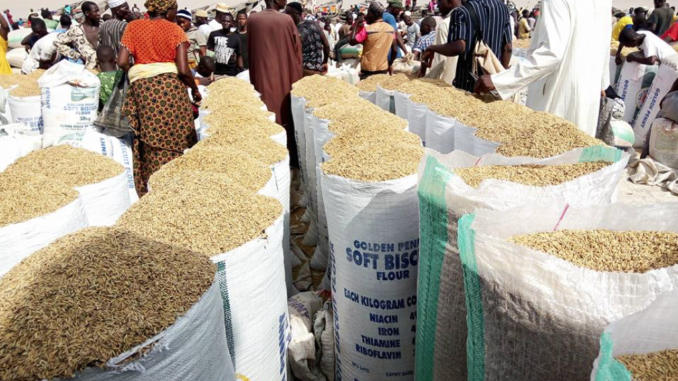
The Kebbi example has shown that Stomach Infrastructure is a government aided fast-track of structured strategies for building sustainable systems for immediate and lasting food security as against the famed politically motivated system of dispensing spot political patronage.
The type of stomach infrastructure (bribe for vote patronage) being promoted by Nigerian politicians is a minus for the people and a disservice to future generations. This is because the opportunity cost is more poverty and the lack of comparable national competitiveness, as well as perennial dependency on foreign countries for food at the expense of local capability and the naira, which weakens with increased imports.
I have had the privilege to engage others in this debate before wherein I stated unequivocally that I support stomach infrastructure.
One of the most prominent states in Nigeria that practices stomach infrastructure as an official policy or a directive principle of state policy is Ekiti State. The state even has an office for stomach infrastructure with a paid official. Unfortunately, what is happening in Ekiti is not stomach infrastructure. It is poverty infrastructure – laying an indigent foundation that can only guarantee that the people will remain poor, beggarly and in squalor.
The word ‘infrastructure’ derives originally from the following keywords: systems, structures and facilities. Infrastructure is a foundational and fundamental concept. Infrastructure is what you have in place that other basic things ride upon.
This is why infrastructure is generally defined as the basic physical and organisational structures and facilities (e.g. buildings, roads, power supplies) needed for the operation of a society or enterprise. Infrastructure connotes a structured provision that gives a society civilised advantages.
Logically, Stomach Infrastructure implies a robust and structured food provision scheme for the potentially underserved. It is the prioritisation of the quest to eradicate food insecurity by accelerating the institutional activation of productive structures and systems that deliver food to the society. Such a system would then confer advantage upon the people by weaning them off food uncertainties (rations and poverty) or dependency on import for essential or staple food consumption thereby ultimately leading to food abundance or surplus.
Sharing gari, elubo or rice, alongside one tuber of yam to able-bodied members of the public in episodes typifying refugee crisis is therefore no stomach infrastructure. Such fatuous activities are superficial and frivolous. They do not provide or require structures or systems that fundamentally guarantee food for the stomachs. They fail to qualify as structural endeavours because they neither impart productivity nor enhance capacity. They are therefore not representative of stomach infrastructure. They rather entrench poverty. They represent Poverty Infrastructure.
A good example of a genuine Stomach Infrastructure programme in Nigeria is the Kebbi Rice project which has demystified polished rice production in Kebbi State (and in Nigeria), crashed the local cost of rice, and ensures that poor Kebbi mothers, children and families can affordably feed themselves, provide massive employment opportunities for hundreds of the poor and open new revenue stream for the Kebbi State Government. The 100,000 metric tonne rice mill in Argungu, Kebbi State, with 10 silos and the capacity to store 18,000 tonnes of rice paddy and has warehouses for storing an additional 12,000 tonnes of rice paddy is a revolution in food security that addresses a key meal preference of Nigerians – rice.
Instructively, part of the remote goals of the Kebbi Rice project is to extend expertise to ordinary local farmers in Kebbi State towards increasing yields among such categories of rice farmers beyond the capacity of the celebrated mill. Following the success recorded in Kebbi State, it is apparent that an average farmer in Argungu in August 2017 would consider it a deep insult if asked to join a queue in order to be given a free bowl or kongo of rice.
If the objective is to cater for the stomach wellbeing of the people, the best approach is to motivate and stimulate productivity among the people. It is worthy of note that it is never too late for any state to reevaluate its priorities or strategies and embark upon this alternative pathway towards food security or stomach infrastructure. It is in fact significant to note that the celebrated Kebbi project only started in February 2016.
In 1961, Nigeria’s domestic consumption of rice was 230,000 metric tonnes. By 2015, Nigeria was doing 5,200,000 metric tonnes at a population above 180 million (UN estimate). The CBN governor, Godwin Emefiele, raised an alarm in July 2015 that the Federal Government spent $2.41 billion on rice importation between January 2012 and May 2015. Even if we close our eyes to the emblematic influence of corruption, there was no way to ascertain what states, local government, private companies or ordinary Nigerians spent on imports or those that were smuggled through the borders. In August 2017, UN estimates that the Nigerian population has crossed the 190 million population line – meaning there are more mouths to feed. If 20 Nigerian states target the production of an average of 300,000 metric tonnes per annum and mobilise the private sector towards this objective, Nigeria will become a net exporter of rice. This principle can be mirrored in other staple foods – yam, cassava and even in animal production – eggs, chicken, turkey, diaries (milk etc) and the likes.
The Kebbi example has shown that Stomach Infrastructure is a government aided fast-track of structured strategies for building sustainable systems for immediate and lasting food security as against the famed politically motivated system of dispensing spot political patronage.
Kebbi State has taught us an important lesson on Stomach Infrastructure – it is doable. It can happen quickly. It is with dignity.
PremiumTimes
END

Be the first to comment